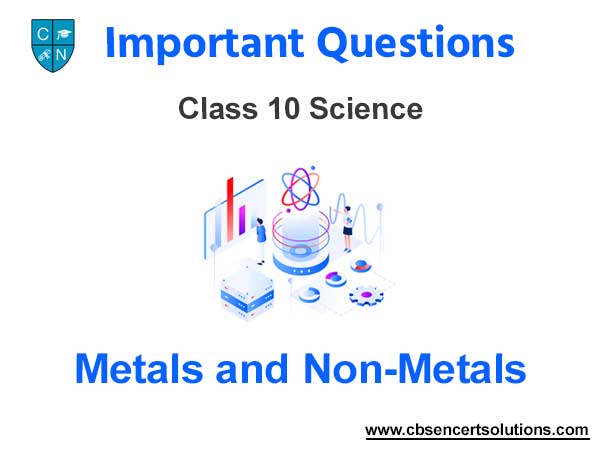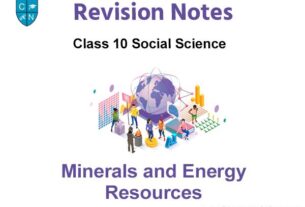Please refer to Chapter 3 Metals and Non-Metals Case Study Questions with answers provided below. We have provided Case Study Questions for Class 10 Science for all chapters as per CBSE, NCERT and KVS examination guidelines. These case based questions are expected to come in your exams this year. Please practise these case study based Class 10 Science Questions and answers to get more marks in examinations.
Case Study Questions Chapter 3 Metals and Non-Metals
Case/Passage – 1
Metals are electropositive elements. They can easily lose electrons to form ions. Metals show distinguished physical as well as chemical properties. Generally most of the metals are ductile and malleable with exception such as mercury. These properties make them valuable for commercial as well as domestic uses. Reaction of a metal with water is one of important chemical property. Metals like sodium and potassium reacts with cold water while magnesium reacts with hot water.
Metals like aluminium, zinc do not react with hot/cold water but they easily react with steam. When a metal react with hot/cold water the products are metal hydroxide and hydrogen,and when it react with steam, the product are metal oxide and hydrogen. Some metals like sodium, potassium react violently with water.
Question: When zinc reacts with steam it produces:
(a) Zn(OH)2
(b) ZnO
(c) O2
(d) ZnO2
Answer
B
Question: During the reaction of calcium with water, pieces of metal start floating due to the formation of:
(a) Ca(OH)2
(b) CO2
(c) H2
(d) none of these
Answer
C
Question: Consider the reactions:
Na(s) + H2O (l) → NaOH (aq) + H2 (g) ……….(i)
Ca(s) + H2O (l) → Ca(OH)2(aq) + H2(g) ………(ii)
(a) Reaction (i) is endothermic reaction.
(b) Reaction (ii) is endothermic reaction.
(c) Reaction (ii) is more exothermic than reaction (i).
(d) Reaction (i) is more exothermic than reaction (ii).
Answer
D
Question: Most ductile metal among the following is:
(a) Au
(b) Ag
(c) Cu
(d) Al
Answer
A
Question: Metals can be converted into thin sheet by hammering.This property is known as:
(a) Ductility
(b) Sonorous
(c) Malleability
(d) Both (a) and (c)
Answer
C
Case/Passage – 2
Elements can be classified as metals or non-metals on the basis of their properties. The easiest way to start grouping substances is by comparing their physical properties. Metals, in their pure state, have a shining surface. This property is called metallic luster. metals are generally hard. The hardness varies from metal to metal. some metals are used for making cooking vessels.
Question: The most abundant metal in the earth’s crust is –
(a) iron
(b) copper
(c) aluminium
(d) mercury
Answer
C
Question: The metal that reacts with cold water is –
(a) mercury
(b) sodium
(c) zinc
(d)tungsten
Answer
B
Question: Metal present in chloroplast is
(a) Iron
(b) Copper
(c) Magnesium
(d) Cobalt
Answer
C
Question: Metals generally are
(a) reducing agents
(b) oxidising agent
(c) both oxidising and reducing agents
(d) None of these
Answer
A
Question: Which of the following metal(s) catch fire on reaction with water?
(a) Sodium
(b) Potassium
(c) Magnesium
(d) both (a) and (b)
Answer
D
Case/Passage – 3
The huge annual loss due to corrosion is a national waste and should be minimized.
Following are some methods which are helpful to prevent corrosion
(i) Coating the iron surface with paint or oil or grease prevents moist oxygen from coming in contact with the metal and thus effectively prevents rusting of iron.
(ii) Galvanisation : Iron is blasted with fine sand to make the surface rough dipped in molten zinc and then cooled. A thin layer of zinc forms on the iron surface. Since zinc ismore reactive than iron, it acts as a sacrificial metal and is preferentially oxidised thus preventing oxidation of iron.
(iii) Electroplating with tin, nickel or chromium also prevents rusting.
(iv) Alloying (mixing iron in its molten state with other metals) prevents rusting. Stainless steel is an alloy of iron with Cr or Ni.
Question: The most convenient method to protect the bottom of ship made of iron is :
(a) coating it with red lead oxide.
(b) white tin plating.
(c) connecting it with Mg block.
(d) connecting it with Pb block.
Answer
C
Question: The best way to prevent rusting of iron is :
(a) making it cathode
(b) putting in saline water
(c) both of these
(d) none of these
Answer
A
Question: The most durable metal plating on iron to protect against corrosion is :
(a) nickel plating
(b) copper plating
(c) tin plating
(d) zinc plating
Answer
D
Case/Passage – 4
Some metals are chemically very reactive, whereas others are less reactive or unreactive. On the basis of vigourness of reactions of various metals with oxygen, water and acids, as well as displacement reactions, the metals have been arranged in a group or series according to their chemical reactivity. The arrangement of metals in a vertical column in the order of decreasing reactivities is called reactivity series of metals (or activity series of metals). In reactivity series, the most reactive metal is placed at the top whereas the least reactive metal is placed at the bottom. As we come down in the series, the chemical reactivity of metals decreases. Since the metals placed at the bottom of the reactivity series (like silver and gold) are less reactive, so they are usually found in free state (native state) in nature.
Question: Copper sulphate solution can be safely kept in a container made of :
(a) aluminium
(b) lead
(c) silver
(d) zinc
Answer
C
Question: When metal Z is added to dilute HCl solution, there is no evolution of gas. Metal is :
(a) K
(b) Na
(c) Ag
(d) Zn
Answer
C
Question: Metal always found in free state is :
(a) gold
(b) silver
(c) copper
(d) sodium
Answer
A



